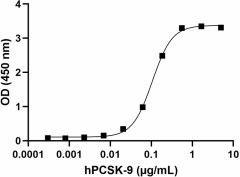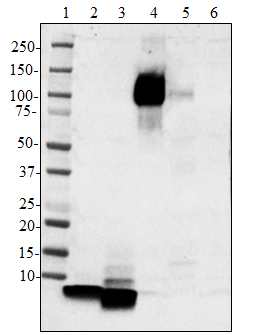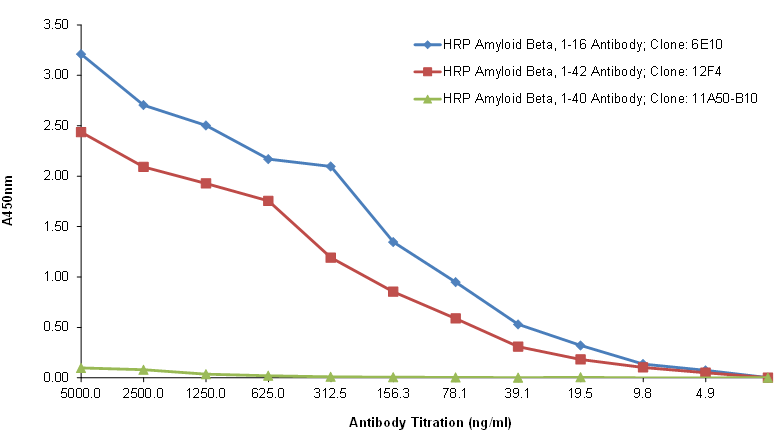- Regulatory Status
- RUO
- Other Names
- Neural Apoptosis Regulated Convertase 1 (NARC1)
- Ave. Rating
- Submit a Review
- Product Citations
- publications

-

When recombinant human LDLR is immobilized at 1 µg/mL, recombinant human PCSK9 binds with ED50 of 0.04 - 0.2 µg/mL in a functional ELISA.
Protein convertase subtilisin/kexin 9 (PCSK9) possesses a signal peptide ( aa 1-30), a prosegment (PRO) (aa 31-152), a catalytic domain (aa 153-407), a hinge region (aa 408-452), and a C-terminal Cys-His-rich domain (CHRD) (aa 453-692). This protein is primarily synthesized and secreted by hepatocytes. Besides liver, it is also expressed in the small intestine, kidney, and brain, and it is present in plasma. Upon translocation to the endoplasmic reticulum, the prosegment of PCSK9 is autocatalytically cleaved at the VFAQ152QSIP site and secreted as a stable, enzymatically inactive, non-covalent complex. Elevated low density lipoprotein-cholesterol (LDLc) level is a major risk factor for cardiovascular disease and atherosclerosis. LDLc is cleared from circulation by the LDL receptor (LDLR); PCSK9 is a regulator of LDLc levels through the binding of LDLR, subsequently leading to the degradation of LDLR. Therefore, it is biologically plausible that drugs inhibiting PCSK9 would lower heart attacks and other diseases caused by increased cholesterol. PCSK9 also binds to other LDLR family members such as very low density lipoprotein receptor (VLDLR), apolipoprotein E receptor (LRP1/APOER), and apolipoprotein receptor 2 (LRP8/APOER2), which lead to their degradation in the intracellular acidic compartments. Like the LDLR, gene expression of PCSK9 is positively regulated by SREBP-2, a transcription factor that is activated in response to cellular cholesterol depletion.
Product DetailsProduct Details
- Source
- Human PCSK9, amino acids (Arg29-Gln692) (Accession# NP_777596) was expressed with C-terminal TGHHHHHHHHGGQ tag in CHO cell line.
- Molecular Mass
- Predicted molecular mass of approximately 73 kD. It migrates as 70 and 17 kD for mature and prodomain, respectively, in DTT-reducing conditions and 63 and 17 kD in non-reducing conditions by SDS-PAGE.
- Purity
- >90%, as determined by Coomassie stained SDS-PAGE.
- Formulation
- 0.22 µm filtered protein solution is in 20 mM Tris, 150 mM NaCl, pH 8.0.
- Endotoxin Level
- Less than 1 EU per µg protein as determine by the LAL method.
- Concentration
- 10 and 25 µg sizes are bottled at 200 µg/mL. 100 µg size and larger sizes are lot-specific and bottled at the concentration indicated on the vial. To obtain lot-specific concentration and expiration, please enter the lot number in our Certificate of Analysis online tool.
- Storage & Handling
- Unopened vial can be stored between 2°C and 8°C for up to 2 weeks, at -20°C for up to six months, or at -70°C or colder until the expiration date. For maximum results, quick spin vial prior to opening. The protein can be aliquoted and stored at -20°C or colder. Stock solutions can also be prepared at 50 - 100 µg/mL in appropriate sterile buffer, carrier protein such as 0.2 - 1% BSA or HSA can be added when preparing the stock solution. Aliquots can be stored between 2°C and 8°C for up to one week and stored at -20°C or colder for up to 3 months. Avoid repeated freeze/thaw cycles.
- Activity
- When recombinant human LDLR is immobilized at 1 µg/mL, recombinant human PCSK9 binds with ED50 of 0.04 - 0.2 µg/mL in a functional ELISA.
- Application
-
Bioassay
- Application Notes
-
BioLegend carrier-free recombinant proteins provided in liquid format are shipped on blue-ice. Our comparison testing data indicates that when handled and stored as recommended, the liquid format has equal or better stability and shelf-life compared to commercially available lyophilized proteins after reconstitution. Our liquid proteins are verified in-house to maintain activity after shipping on blue ice and are backed by our 100% satisfaction guarantee. If you have any concerns, contact us at tech@biolegend.com.
Antigen Details
- Structure
- Monomer
- Distribution
-
Hepatocytes, neuro-epithelioma, colon carcinoma, Schwann cells
- Function
- PCSK9 regulates LDLR, VLDLR, APOER, and APOER2 levels, and, therefore LDLc level. PCSK9 is regulated by SREBP-2.
- Interaction
- Hepatocytes
- Ligand/Receptor
- LDLR, VLDLR, APOB, LRP1, LRP8
- Biology Area
- Cell Biology, Neuroinflammation, Neuroscience, Signal Transduction
- Molecular Family
- Enzymes and Regulators
- Antigen References
-
1. Seidah NG, et al. 2003. Proc. Natl. Acad. Sci. USA 100:928.
2. Naureckiene S, et al. 2003. Arch. Biochem. Biophys. 420:55.
3. Costet P, et al. 2008. Trends Biochem. Sci. 33:426.
4. Tibolla G, et al. 2011. Nutr. Metab. Cardiovasc. Dis. 21:835. - Gene ID
- 255738 View all products for this Gene ID
- UniProt
- View information about PCSK9 on UniProt.org
Related Pages & Pathways
Pages
Related FAQs
- Why choose BioLegend recombinant proteins?
-
• Each lot of product is quality-tested for bioactivity as indicated on the data sheet.
• Greater than 95% Purity or higher, tested on every lot of product.
• 100% Satisfaction Guarantee for quality performance, stability, and consistency.
• Ready-to-use liquid format saves time and reduces challenges associated with reconstitution.
• Bulk and customization available. Contact us.
• Learn more about our Recombinant Proteins. - How does the activity of your recombinant proteins compare to competitors?
-
We quality control each and every lot of recombinant protein. Not only do we check its bioactivity, but we also compare it against other commercially available recombinant proteins. We make sure each recombinant protein’s activity is at least as good as or better than the competition’s. In order to provide you with the best possible product, we ensure that our testing process is rigorous and thorough. If you’re curious and eager to make the switch to BioLegend recombinants, contact your sales representative today!
- What is the specific activity or ED50 of my recombinant protein?
-
The specific activity range of the protein is indicated on the product datasheets. Because the exact activity values on a per unit basis can largely fluctuate depending on a number of factors, including the nature of the assay, cell density, age of cells/passage number, culture media used, and end user technique, the specific activity is best defined as a range and we guarantee the specific activity of all our lots will be within the range indicated on the datasheet. Please note this only applies to recombinants labeled for use in bioassays. ELISA standard recombinant proteins are not recommended for bioassay usage as they are not tested for these applications.
- Have your recombinants been tested for stability?
-
Our testing shows that the recombinant proteins are able to withstand room temperature for a week without losing activity. In addition the recombinant proteins were also found to withstand four cycles of freeze and thaw without losing activity.
- Does specific activity of a recombinant protein vary between lots?
-
Specific activity will vary for each lot and for the type of experiment that is done to validate it, but all passed lots will have activity within the established ED50 range for the product and we guarantee that our products will have lot-to-lot consistency. Please conduct an experiment-specific validation to find the optimal ED50 for your system.
- How do you convert activity as an ED50 in ng/ml to a specific activity in Units/mg?
-
Use formula Specific activity (Units/mg) = 10^6/ ED50 (ng/mL)













Follow Us